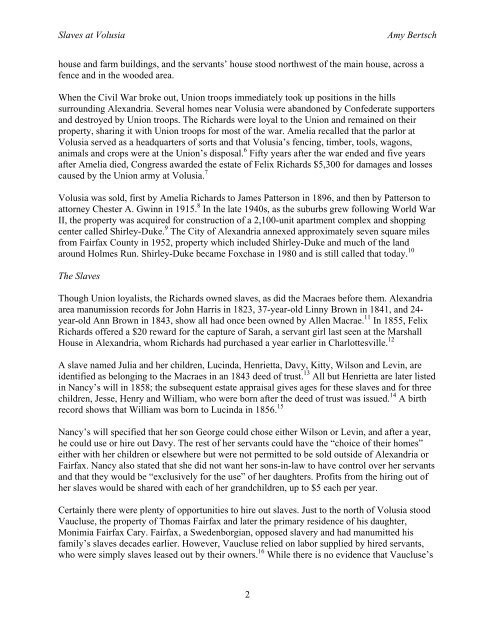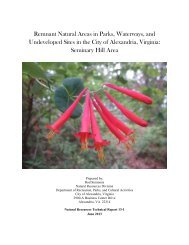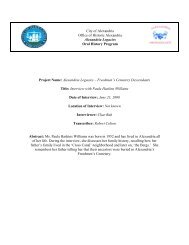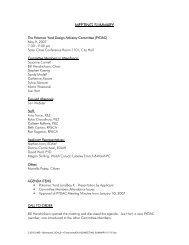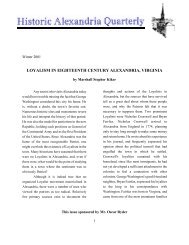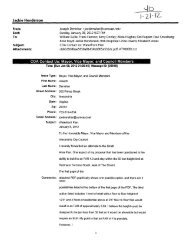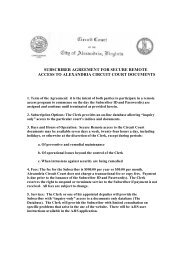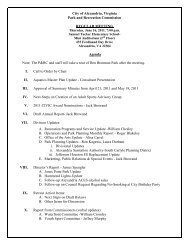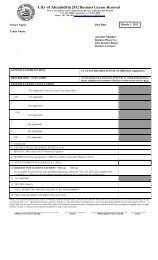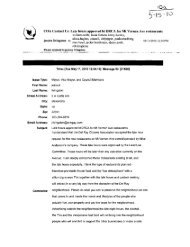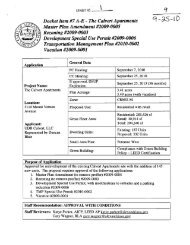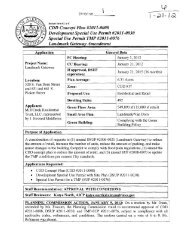Slaves at Volusia - City of Alexandria
Slaves at Volusia - City of Alexandria
Slaves at Volusia - City of Alexandria
Create successful ePaper yourself
Turn your PDF publications into a flip-book with our unique Google optimized e-Paper software.
<strong>Slaves</strong> <strong>at</strong> <strong>Volusia</strong> Amy Bertsch<br />
house and farm buildings, and the servants’ house stood northwest <strong>of</strong> the main house, across a<br />
fence and in the wooded area.<br />
When the Civil War broke out, Union troops immedi<strong>at</strong>ely took up positions in the hills<br />
surrounding <strong>Alexandria</strong>. Several homes near <strong>Volusia</strong> were abandoned by Confeder<strong>at</strong>e supporters<br />
and destroyed by Union troops. The Richards were loyal to the Union and remained on their<br />
property, sharing it with Union troops for most <strong>of</strong> the war. Amelia recalled th<strong>at</strong> the parlor <strong>at</strong><br />
<strong>Volusia</strong> served as a headquarters <strong>of</strong> sorts and th<strong>at</strong> <strong>Volusia</strong>’s fencing, timber, tools, wagons,<br />
animals and crops were <strong>at</strong> the Union’s disposal. 6 Fifty years after the war ended and five years<br />
after Amelia died, Congress awarded the est<strong>at</strong>e <strong>of</strong> Felix Richards $5,300 for damages and losses<br />
caused by the Union army <strong>at</strong> <strong>Volusia</strong>. 7<br />
<strong>Volusia</strong> was sold, first by Amelia Richards to James P<strong>at</strong>terson in 1896, and then by P<strong>at</strong>terson to<br />
<strong>at</strong>torney Chester A. Gwinn in 1915. 8 In the l<strong>at</strong>e 1940s, as the suburbs grew following World War<br />
II, the property was acquired for construction <strong>of</strong> a 2,100-unit apartment complex and shopping<br />
center called Shirley-Duke. 9 The <strong>City</strong> <strong>of</strong> <strong>Alexandria</strong> annexed approxim<strong>at</strong>ely seven square miles<br />
from Fairfax County in 1952, property which included Shirley-Duke and much <strong>of</strong> the land<br />
around Holmes Run. Shirley-Duke became Foxchase in 1980 and is still called th<strong>at</strong> today. 10<br />
The <strong>Slaves</strong><br />
Though Union loyalists, the Richards owned slaves, as did the Macraes before them. <strong>Alexandria</strong><br />
area manumission records for John Harris in 1823, 37-year-old Linny Brown in 1841, and 24year-old<br />
Ann Brown in 1843, show all had once been owned by Allen Macrae. 11 In 1855, Felix<br />
Richards <strong>of</strong>fered a $20 reward for the capture <strong>of</strong> Sarah, a servant girl last seen <strong>at</strong> the Marshall<br />
House in <strong>Alexandria</strong>, whom Richards had purchased a year earlier in Charlottesville. 12<br />
A slave named Julia and her children, Lucinda, Henrietta, Davy, Kitty, Wilson and Levin, are<br />
identified as belonging to the Macraes in an 1843 deed <strong>of</strong> trust. 13 All but Henrietta are l<strong>at</strong>er listed<br />
in Nancy’s will in 1858; the subsequent est<strong>at</strong>e appraisal gives ages for these slaves and for three<br />
children, Jesse, Henry and William, who were born after the deed <strong>of</strong> trust was issued. 14 A birth<br />
record shows th<strong>at</strong> William was born to Lucinda in 1856. 15<br />
Nancy’s will specified th<strong>at</strong> her son George could chose either Wilson or Levin, and after a year,<br />
he could use or hire out Davy. The rest <strong>of</strong> her servants could have the “choice <strong>of</strong> their homes”<br />
either with her children or elsewhere but were not permitted to be sold outside <strong>of</strong> <strong>Alexandria</strong> or<br />
Fairfax. Nancy also st<strong>at</strong>ed th<strong>at</strong> she did not want her sons-in-law to have control over her servants<br />
and th<strong>at</strong> they would be “exclusively for the use” <strong>of</strong> her daughters. Pr<strong>of</strong>its from the hiring out <strong>of</strong><br />
her slaves would be shared with each <strong>of</strong> her grandchildren, up to $5 each per year.<br />
Certainly there were plenty <strong>of</strong> opportunities to hire out slaves. Just to the north <strong>of</strong> <strong>Volusia</strong> stood<br />
Vaucluse, the property <strong>of</strong> Thomas Fairfax and l<strong>at</strong>er the primary residence <strong>of</strong> his daughter,<br />
Monimia Fairfax Cary. Fairfax, a Swedenborgian, opposed slavery and had manumitted his<br />
family’s slaves decades earlier. However, Vaucluse relied on labor supplied by hired servants,<br />
who were simply slaves leased out by their owners. 16 While there is no evidence th<strong>at</strong> Vaucluse’s<br />
2


